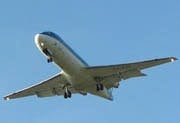The Environmental Protection Agency has reached settlements with 11 major domestic airlines and 13 smaller airlines to ensure the safety of the drinking water used by their passengers and crew. The settling airlines have agreed to routinely monitor the quality of water on their airplanes. The action came after an EPA investigation of 327 U.S. and foreign flag airlines at 19 airports in 2004 found total coliform contamination in the drinking water in 15 percent of aircraft.
Total coliform is an indicator that other disease-causing organisms (pathogens) could be in the water and could potentially affect people's health. The settlements require the airlines to regularly monitor aircraft water systems; notify EPA and the public when tests reveal contamination; and regularly disinfect aircraft water systems and water transfer equipment. The orders also require each airline to study possible sources of contamination from outside of the aircraft.
The information released will help the traveling public make informed decisions. Passengers with compromised immune systems or others concerned may want to request canned or bottled beverages. EPA will update its information and advice to the traveling public as soon as new information is available at: http://www.epa.gov/airlinewater.
"EPA and these airlines worked together to establish new practices for protecting the health of the flying public," said Grant Nakayama, EPA's assistant administrator for enforcement and compliance assurance. "We will continue to monitor the safety of water on airlines that use U.S. airports while the agency develops regulations specifically for airline drinking water."
Ben Grumbles, EPA's assistant administrator for the Office of Water, insisted: "The water passengers drink on a plane should be as safe as the water they drink at home. The settlements announced today show that it's time to fine-tune and upgrade EPA's water regulations to specifically address airplanes."
The settlements announced were reached with: AirTran Airways, Alaska Airlines, Aloha Airlines, American Airlines, America West, ATA Airlines, Champion Air, Continental Airlines, Continental Micronesia,
Falcon Air Express, Frontier Airlines, Hawaiian Airlines, Miami Air International, Midwest Airlines, North American Airlines, Northwest Airlines, Pace Airlines, Ryan International Airlines, Spirit Airlines, Sun Country Airlines, United Airlines, US Airways, USA 3000 Airlines, and World Airways. The 11 major domestic airlines who have settled are members of the Air Transport Association, whose 14 members account for 90 percent of U.S. air travel.
EPA is negotiating agreements with Omni Air International and the three remaining members of the Air Transport Association: Delta Airlines, JetBlue Airways, and Southwest Airlines. EPA will continue to work with smaller, regional and charter airlines to ensure drinking water quality with agreements similar to those reached with airlines that belong to the Air Transport Association and the National Air Carrier Association and Air Carrier Association of America.
Meanwhile, EPA is developing regulations for water that is served onboard aircraft. EPA held a public meeting in June as part the development process for the airline drinking water rule.
For more information on the regulation of water supplies aboard passenger aircraft, to view publicly available testing data, and read a summary of the June 2004 public meeting, visit: http://www.epa.gov/airlinewater.
Source: EPA


